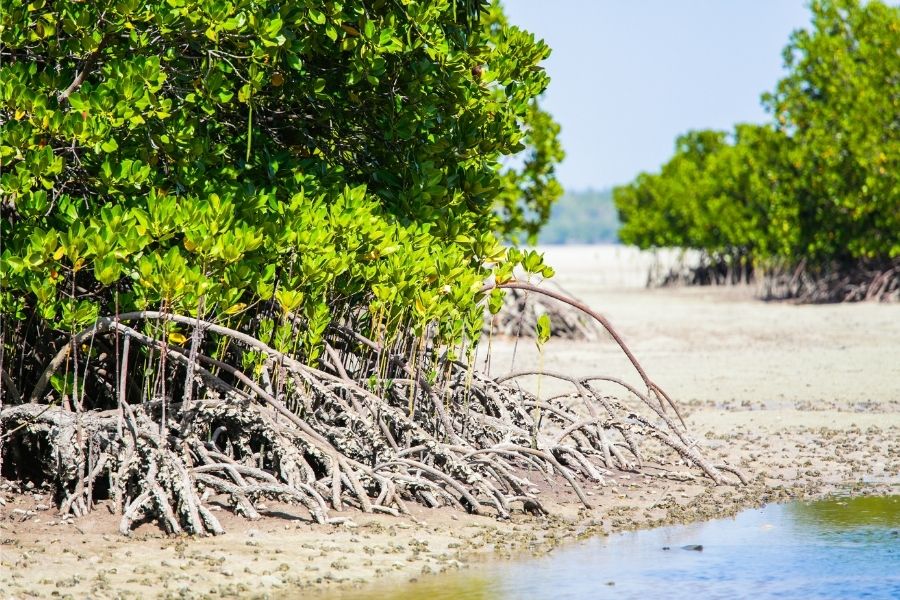We begin our botanical safari, where the palm-fringed beaches of the Indian Ocean welcome weary travelers to Kenya’s shores.
The coconut palms and the whistling pine(casuarina) we find there also arrived here as travelers, having floated in as seeds from the Pacific. They anchor the sand, stabilize the shoreline, and provide shade thatching, fuel, and a delicious Madafu drink.
Mangroves line the bays and coastal creeks of much of the Kenyan coastline, a unique group of trees especially adapted to living between the tides with their roots covered by seawater twice a day. And in the muddy ground below them, thousands of fiddler crabs display one oversized claw as they stand guard at the entrance to their burrows.
Traveling inland from the coast, our safari takes us to the silent Ruins of Gedi National Monument in Watamu, where a long-deserted Swahili town nestles along the coral rag forest.
Here, there are massive Baobab trees and tall Gyro-carpus trees with seeds like helicopter rotor blades while only a few kilometers away, the Arabuko Sokoke forest Reserves offer us a choice of three forests in One: thick mixed coastal forest, open woodland on white soil, and low, dense thicket on red soil.
Heading inland, the vegetation changes rapidly to that of an arid landscape, and here, where the Mombasa – Nairobi highway bisects Kenya’s largest National Park, we find Tsavo East and Tsavo West, a vast expanse of pink sand and green bush, much of it acacia-commiphora woodland.
Over 40 species of acacia grow in Kenya, ranging from low-hunched bushes with ‘wait a bit’ thorns to beautifully graceful flat-topped trees. Above this bushland towers the magnificent Baobab trees.



From here, the land rises, and the landscape changes to the rolling grassland and wooded hills that stretch to Mt. Kilimanjaro in the south and Nairobi in the center of Kenya. Here, the city roads are bright with flowering plants worldwide.
The Bougainvillea has brilliant borders, purple avenues of Jacaranda, waving palms from California, and tall indigenous Nandi flames (African Tulip Trees) with large, cup-shaped flowers.
Many of the world’s crops are also grown near Nairobi, including coffee, tea, and roses for Export, Maize, wheat, potatoes, and beans for local consumption, and fruits ranging from apples to pineapples.
Mount Kenya, the core of an Ancient volcano that stands almost astride the Equator, is surrounded by farmland. Higher up the mountain is ringed by belts of thick vegetation made up of highland forests, mountain bamboo, mountain forest, shrubs, and moorland where giants form of Senecio and lobelia can be found.
Meanwhile, set like jewels down on the floor of the Great Rift Valley are the series of lakes, many of them Alkaline. On one of them, the freshwater Lake Naivasha, the thick sand of Papyrus reeds at the water’s edge filters out sediments and pollutants. At the same time, around the shores of Lake Naivasha, Nakuru, and Elementaita, handsome yellow-barked acacias and candelabra euphoria stand tall.
And you are moving on from the Great Rift Valley…. Who knows where your safari may take you? If you visit the famous Masai Mara, you will find grasslands of red oat grass that feed great herds of large herbivores.
If you take in Samburu, you’ll find graceful doum palms with branched trunks that adorn the dry landscape. If you travel to western Kenya, you will find the little chunk of the once vast central African rain forest called the Kakamega forest.
But to see all the gloriously varied landscapes that make up the marvel lousily diverse mosaic and botanical Kenya …. You have to book another safari.
References:
Some of the valuable books to use on your botanical safari include;
-
Field Guide to the Wildflowers of East Africa. By Michael Blundell, 1987, HarperCollins
-
Trees of Kenya. By Tim Noad and Ann Birnie, 1989, T.C Noad &A. Birnie, Nairobi.
-
Wayside flowers of East Africa. By Teresa Sapieha, 1989, Sapieha, Nairobi, Reprinted 2000



